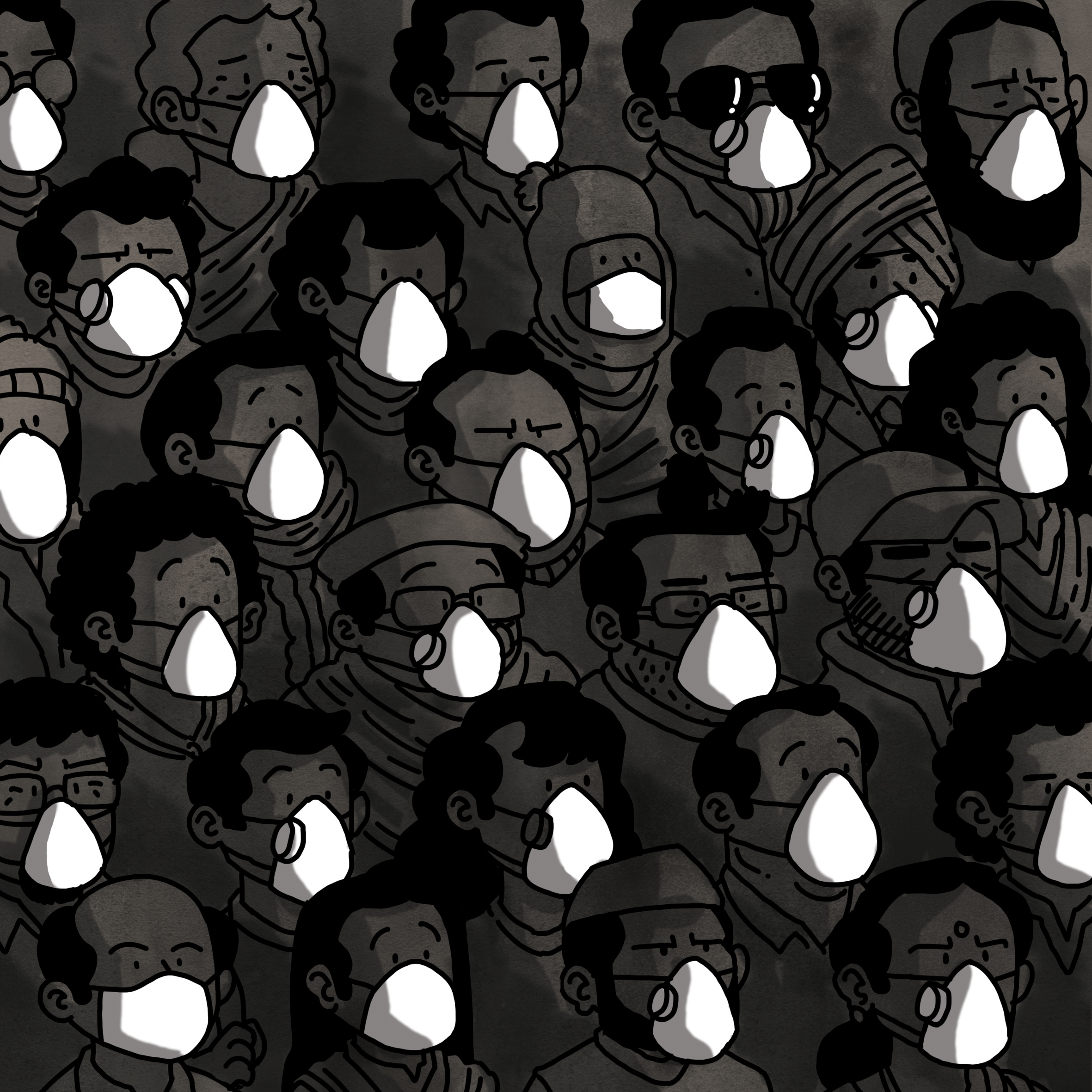With every breath, we inhale heavy metals like nickel, lead, silicon and manganese. No wonder, the number of patients suffering from respiratory issues is on the rise
With no previous history of respiratory ailments, 52-year-old Keshav Mohanan began complaining of persistent cough and breathing issues in November when the air pollution in Delhi reached unprecedented levels. “My condition was so severe that doctors advised me to stay indoors and I had to take a week-long break from work. In the evenings, breathlessness used to increase drastically. Since during that time the Capital was reeling under air pollution, doctors said that it was because of the toxic air as I did not have any pulmonary disorder,” Mohanan says.
Due to the polluted air in Delhi, many asthma patients, particularly those with Chronic Obstructive Pulmonary Disease (COPD), experience acute attacks and other problems that aggravate their condition. Even those with no prior history of such ailments begin experiencing breathing issues. There has been a sudden increase in the footfall of patients with respiratory issues since the air pollution peaked in November. Vivek Nangia, pulmonologist and head of the Lung Centre at Vasant Kunj’s Fortis Hospital, said that his OPD also witnessed an increase in the number of such patients —about 15-20% — because of the contaminated air.
“I am an asthma patient and the air pollution after Diwali and around winters in Delhi has been really troublesome for the last two years. This year, I had to go to my aunt’s place in Nainital because it became extremely difficult for me to deal with the air outside. I spent my entire winter vacations there,” says Ayush Jain, a 19-year-old Delhi University student. Last year too, he experienced severe asthma attacks when the air pollution spiked to the severe category. He adds, “The occurrence and the severity of my asthma attacks increased after Diwali. The air was so polluted that many people with no such ailments were having difficulty in breathing. So, you can imagine how bad it can get for people like us.”
A 50% surge in patients complaining of breathing problems was reported in November when Delhi’s air became totally unfit to breathe. Dr Raj Kumar, head of the department of pulmonary medicine at Vallabhbhai Patel Chest Institute, says, “Not only patients with pre-existing respiratory complications suffer, but we also see normal patients complaining of breathlessness.”
Jayesh Hirnandani, a 49-year-old chartered accountant, had to be hospitalised in AIIMS, as he was afflicted with acute chest pain and coughing. “In 2017, we all had heard about how toxic Delhi’s air had become when it was covered under a thick blanket of smog. Last year, I had to face the ill-effects of it. The coughing and chest pain was so terrible that I had to get my chest examined and an x-ray done. The doctors did not find any abnormality, so they said that it might be because of the pollution,” he says, adding, “One day when I came back from work, the pain had reached such an unbearable level and my family got so worried that I had to be hospitalised and kept under observation.”

Dr Ravi Bhaskar, a pulmonologist, says, “When the AQI had dipped into the ‘very poor’ category, I used to see around 10-20 patients a day, who used to complain of some allergy, cough, other respiratory problems and even watery eyes. Many of them used to be fresh cases.”
“Lung diseases are on the rise. In my OPD, I see as many people who smoke with lung cancer as non-smokers. This is directly because of the polluted air. Why else would a non-smoker develop lung cancer? I see one or two cases every day. Around 30 years back, 10% cases of lung cancer were seen in non-smokers, as against 90% in the case of smokers. Today, I’m reporting a 50% distribution in case of non-smokers,” says Dr Arvind Kumar, pulmonologist at Sir Ganga Ram Hospital.
He further says that a few days ago, a woman who was suffering from lung cancer came to consult him and her husband said that he had heard that lung cancer develops because of smoking cigarettes or bidi, but his wife never smoked. “I told them that it’s because of the pollution. Unfortunately, despite all the noise made by the media about air pollution and its ill-effects, its percolation into public minds has been abysmally low,” he adds.
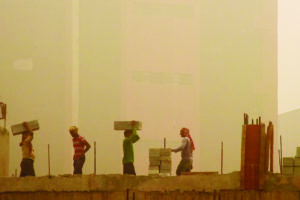
Dr Kumar says that he has been seeing many patients suffering from a persistent cough. “Patients who had undergone an operation also come complaining of cough. Whenever the air pollution increases, they start fearing that their disease has relapsed. But I get a chest x-ray done and there is nothing. Then I have to explain that it is because of the pollution and they seem to look so startled when they hear that. I’m seeing this every day, what proof do people want? Sit in my OPD for four hours and you’ll get the proof,” he explains.
Lungs are not alone
But Delhi’s polluted air is not just affecting your lungs and resulting in respiratory disorders, it might also be adversely affecting your brain, memory, IQ, learning and behaviour. Results of a study —‘Death in Every Breath’ — that were released recently by the NGO Lung Care Foundation revealed high levels of neurotoxins in Delhi’s air that can cause damage to the brain or the peripheral nervous system. Growing evidence suggests that inhalation of fine and ultrafine particles commonly found in air pollution can damage the brain and increase the risk of developing dementia and Alzheimer’s disease.
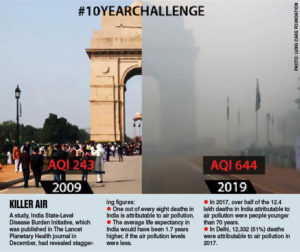
Samples of air taken from Delhi and Gurugram in November and December 2018 point towards an alarming presence of toxic heavy metals like manganese, nickel and lead, in addition to PM2.5. These samples were taken from the residential areas of Safdarjung Enclave, Gurugram Sector 67 and DLF Phase 5. Levels of manganese in five samples were found to be much higher than the US standard, while nickel concentration exceeded WHO guidelines in all seven samples. Lead levels exceeded the US safe standard in six samples and extremely high levels of barium were detected around Diwali. PM2.5 levels in all the seven samples were above statutory limits, ranging from 90.3 ug/m3 to 563.5 ug/m3 —1.5 and 9.4 times higher than the standards prescribed by the Union Environment Ministry. High levels of barium were found in three samples taken around Diwali.
The study states: “Levels of silicon were seen elevated in all the samples. Locations near coal ash piles or where sand is being processed, such as a construction sites, might contribute to the elevated levels of crystalline silica in ambient air that can cause respiratory health effects, if exposures are prolonged. It is quite clear that the construction activities have a negative impact on the air quality and are threatening public health. It is not just aggravating the already poor air quality in the region but also contributing toxic metal like silica, iron, manganese, nickel and lead to the air.”
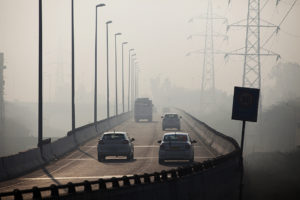
Dr Kumar, who is also the Founder Trustee at Lung Care Foundation and the author of the study, says, “Manganese and lead are neurotoxins that can damage the nervous system. It affects children the most, since they have organs that are growing and developing. Their growth and development get affected. In adults, the tissues have already developed so such chemicals will at best affect the functioning or lead to a tumour.”
The study did not analyse the health aspect but “the effects can be established taking a cue from the known impact of manganese and lead,” says Dr Kumar. “They are known to cause attention deficit disorder or altered attention span in children, which is so commonly being observed in schools these days,” he says, adding, “For older people, it might cause inflammation of the brain and it can manifest in numerous ways. There are a couple of studies that have found that dementia can be correlated with high levels of pollutants.”
He says that silica, the presence of which was also very high, gets deposited in the lungs, which can cause fibrosis. In children, it affects the development of lungs and in adults it can lead to fibrosis and ultimately predispose them to COPD and lung failure.
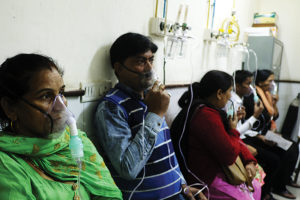
“Finding these heavy metals in the air is a very dangerous development. I have already sent the report to the CPCB (Central Pollution Control Board). We need to conduct further research to find a solution,” he concludes.
Tracking the traces
According to the data collected through e-pharmacy 1mg’s disease tracker — that keeps a tab on the medicines that are being ordered and then analyses the diseases that are cured by those medicines to compile a list of the ‘trending’ diseases — the sale of Ayurvedic respiratory products saw three times increase from October to December and other respiratory products saw five times increase. “The sale of masks also peaked during these months, as is expected. Looking at the trends for allergies, Chronic Obstructive Pulmonary Disease (COPD) and asthma, we noticed that all these were exacerbated by pollution because there was an increase of 400% over the normal trend through the rest of the year in case of these conditions,” says Gaurav Agarwal, co-founder of 1mg.
Even though Delhiites breathed cleaner air when the AQI reached satisfactory levels on Wednesday after the rainfall, it deteriorated the very next day as the impact of rain reduced. This brings us back to the question — will we ever be able to breathe clean air?
With inputs from Sashikala VP and Proma Chakraborty
Beyond PM2.5
Particulate matter (PM 2.5) is an air pollutant that predominantly comes to the fore when the point at issue is Delhi’s air quality. But a recent study has revealed that PM 2.5 is not the only pollutant that has a detrimental impact on our health and lung is not the only organ that is affected.
Air samples taken from Delhi and Gurugram in November and December reveal the presence of toxic heavy metals in the air, along with PM2.5. As per the report, ‘Death in Every Breath’, released by Lung Care Foundation, particulate matter (dust less than 2.5 micrometres in size) was beyond the statutory level in all the seven samples taken. The report documents the threat posed by other metals that mostly does not get accounted.
Murderous metals
Manganese: Levels of manganese in five of the seven samples exceed the U.S standard and the WHO annual health-based guidelines value of 0.15 ug/m3.
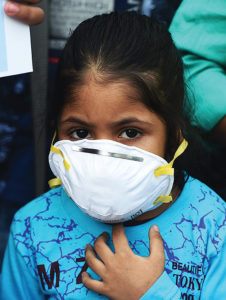
Health effects: Long term exposure can cause permanent brain damage. Inhalation causes irritation in nose, lungs, throat, causing coughing, sneezing and shortness of breath. It may also cause harm to the liver and testes and decrease fertility in males. Chronic exposure to higher levels is characterised by feelings of weakness and lethargy, tremors, a mask-like face and psychological disturbances.
Lead: Levels of lead in two samples exceed the Indian NAAQS (National Ambient Air Quality Standards Annual) and WHO annual health-based guidelines value of 0.05 ug/m3 and in six of the seven samples exceeds the US standards.
Health effects: Exposure to lead can cause brain swelling, kidney disease, cardiovascular problems, nervous system damage and death. There is no safe level of lead exposure, especially for children. Exposures to low levels of lead early in life have been linked to effects on IQ, learning, memory and behaviour.
Nickel: The level of nickel in all samples exceeds the WHO annual health-based guidelines value of 0.0025 ug/m3, which is based on the risk of cancer associated with long-term exposure to nickel.
Health effects: Nickel is a probable carcinogen for lung cancer. Acute exposure can cause headache, dizziness, nausea and vomiting. Inhalation can irritate and cause damage to the nose, throat and lungs. It can also lead to chronic bronchitis and scarring of the lungs. Long-term exposure may also harm the liver and kidneys.

